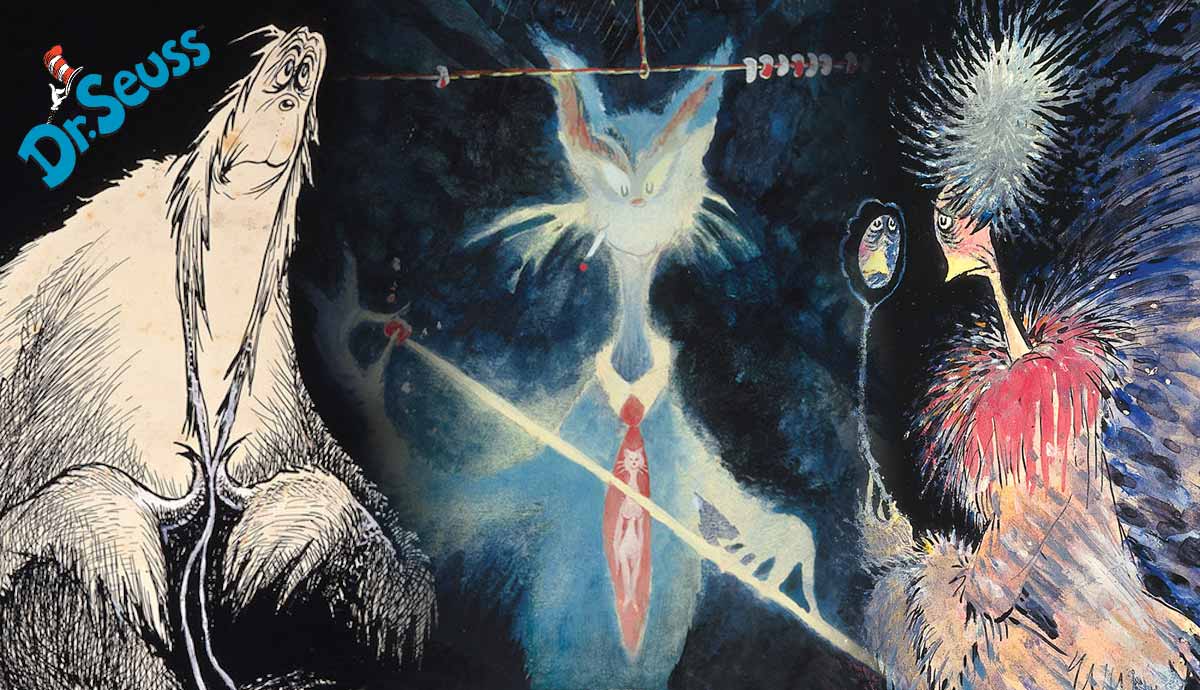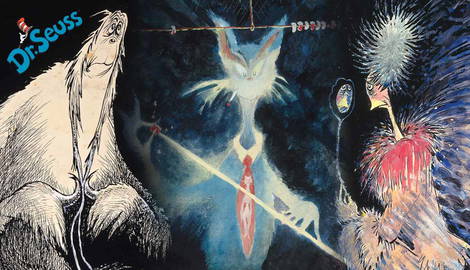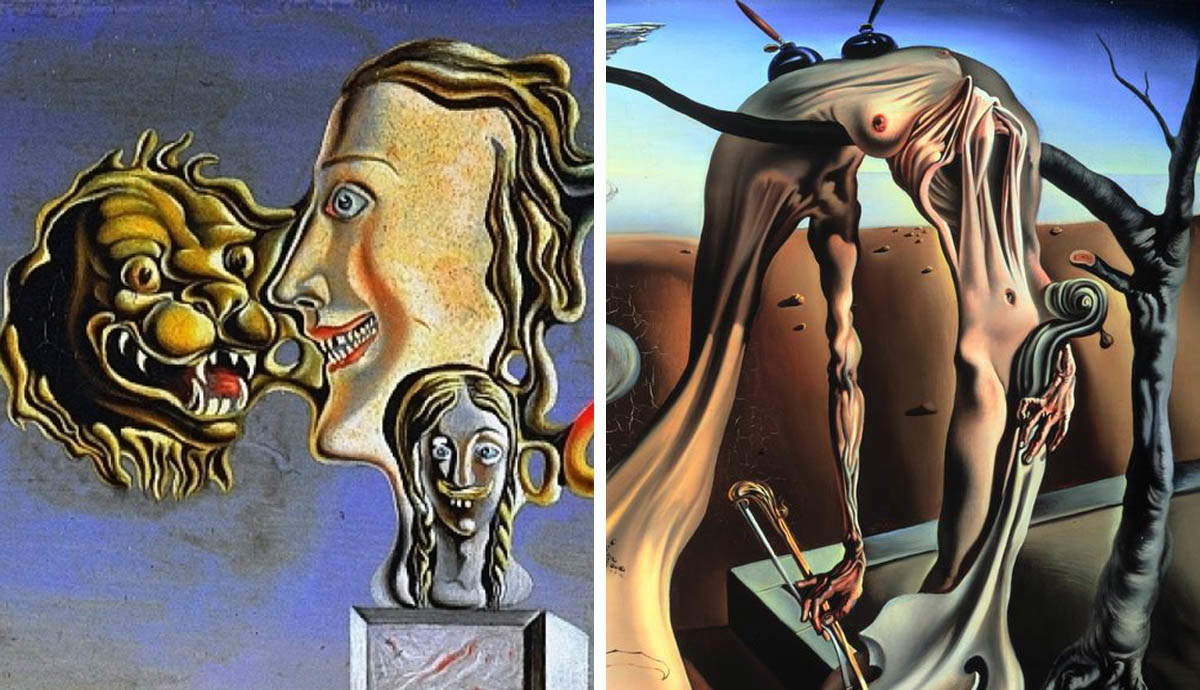
Theodor Seuss Geisel, better known as Dr. Seuss, was a beloved American children’s book author and illustrator. His gift of rhyming, inventing words, and creating unique creatures continues to bring joy to children and adults everywhere. From making political cartoons to developing advertisements for insect repellent, he established himself as a man of many talents. Although he did write books for adults, they weren’t received as well, and he preferred gearing his work towards children. Along these lines, however, a collection of darker paintings he created exists that isn’t that appropriate for an audience of younger viewers. Dr. Seuss’s Midnight Paintings were made in secret and not meant to be seen by the public until after his death.
Before Dr. Seuss’s Midnight Paintings

Seuss was born in 1904 in Massachusetts and moved to New Hampshire at 18 to go to Dartmouth College. While there, he was the editor-in-chief of their humor magazine, Jack-O-Lantern, and continued to be secretly, even after he was fired due to violating the Prohibition law. He got away with this because he used the pen name Seuss. Later, he attended the University of Oxford after graduating, with hopes to become a professor. However, he decided to drop out in 1927 and follow a path of cartooning full-time back in the states.
LIFE and Vanity Fair published his articles and cartoons early on and his cartoon in the July 1927 issue of The Saturday Evening Post led him to a job with the New York weekly Judge. This publication was the first instance of his pseudonym Seuss being used in a well-established source. He worked for Standard Oil as an advertiser for 15 years and broke into the world of children’s literature drawing illustrations for a book collection titled Boners. He was involved in politics with the start of WWII, creating weekly political cartoons for PM Magazine and making official animated training films and propaganda posters. Dr. Seuss published over sixty books, the first one being And to Think I Saw It on Mulberry Street in 1937.

His first well-known book to be released was Horton Hears a Who in 1954. Three years later, an article in LIFE exposed children’s poor reading levels. This motivated the publishers at Houghton Mifflin and Random House to request a book from Geisel using only 220 vocabulary words, which resulted in The Cat in the Hat. This was the book that majorly launched his career as a children’s book author and illustrator. Although he’s known for his childlike drawings in his iconic classics like Green Eggs and Ham (1960) and One Fish Two Fish Red Fish Blue Fish (1960), his Midnight Paintings reveal another side of his artistry.
The Midnight Paintings

The Midnight Paintings were created by Geisel typically at night and for himself alone. In this space, he had the freedom to paint darker, more graphic pieces. He didn’t want the paintings to impact his career in children’s literature and didn’t even consider himself a fine artist most of the time. However, his private time of creation allowed him to explore controversial topics like the fear of death, sexuality, and drug use.
Cat from the Wrong Side of the Tracks

The Cat in the Hat (1957) is one of Dr. Seuss’s legendary books and characters. Known from his children’s books, the cat reappears in many of the paintings he created in secret. In Cat from the Wrong Side of the Tracks, the cat prepares for its next play in a game of pool. He’s seen smoking a cigarette while a string hovers above him, with eight beads on the right side and only one on the left.
Geisel was a life-long smoker who was determined to never smoke in front of a child. In 1981, he had a minor heart attack and was instructed by his doctor to quit. He attempted to quit several times, utilizing strange tactics and mixing unusual concoctions. Several of these paintings show the main character smoking, suggesting that these are self-portraits.
The 9 ball is an easy shot on the pool table, which is correlated to the fact that there are 9 beads. The myth of cats having nine lives is being explored here, with only one bead (or “life”) left and an opening for the last life to be swiftly knocked down. This painting seems to be an illustration of how fleeting life can be, and how quickly it can all be taken away with just one targeted motion. All of the listed elements are drastically different from the art we’re all familiar with.
Cat in Obsolete Shower Bath

Cat in Obsolete Shower Bath is another work showing the artist’s alter ego. The background is made up of darker colored brushstrokes, primarily green, blue, black, and hints of brown. In the middle is a shower head connected to the wall with a floating bright green and yellow shower curtain shielding the cat who’s standing under the running faucet.
This piece may be an homage to a time when Dr. Seuss had no fame and wasn’t living the luxurious life he was in his final days. One such time was when he lived with his friend from Dartmouth in a New York City studio. It was located right above an underground nightclub and the hall they lived in shared a communal bathroom. The painting may have been inspired by reflecting on less financially stable times.
Beyond this literal interpretation of the cat showering, it’s also an image of isolation and loneliness in a broader sense. The creature’s face and upper body are completely covered by the shower curtain, stripping away his personality and any solemn expression he may be wearing. Although the viewer can’t read the cat’s face, his posture and stance indicate a moment of depression. The faucet is leaky, symbolizing weakness and damaged goods. A lot can be perceived from this piece with only the character’s legs and tail visible.
Gosh! Do I Look as Old as All That!

La Jolla, CA was his home since 1948 when he bought a rundown observational tower on Mt. Soledad there. His house surrounded it while the tower served as his art studio. Sitting up high and working every day, he named himself a bird watcher on the social scene. From his view, he could people-watch and observe his neighbors below. This led to a series of paintings called The La Jolla Birdwomen. La Jolla is a wealthy neighborhood near San Diego, so many of the women he observed and drew whimsical versions of were visibly rich and fashionable.
The subjects of obsession with image and fear of aging are presented in Gosh! Do I look as Old as all That. The titles in these darker collections of paintings were often straightforward, providing clues to the work’s meaning. In this one, we see a bird-woman wearing a fancy vivacious outfit with pink textured details holding out a hand mirror. The background is made up of dark brushstrokes, using mostly blue and purple tones. An aggressively drawn lamp with black lines for definition provides a light source.
The woman’s side profile shows a sad expression which is reflected back to her through the mirror. The wealthy are often associated with a love of material items and youth, collecting expensive possessions and maintaining an outward appearance that defies the natural aging process. Even after all that this bird-woman must have done to preserve her youth and present herself to the world the way she desired, she still laments growing older. This piece is less of a self-portrait and more of Geisel noticing people’s behavior around him.
Dr. Seuss’s Midnight Paintings Self-Portrait

Dr. Seuss’s titles sometimes provide exact direction towards how he wanted his artwork to be interpreted. The creature in this painting is clearly a self-portrait of Dr. Seuss and as the name indicates, he is anxious about working on what comes next. Interestingly enough, he painted this after the incredible reception of The Cat in the Hat and How the Grinch Stole Christmas. This is fascinating because it shows the stress that an artist can be under even when he’s successful. The anxiety subsided eventually because what followed was the well-loved book Green Eggs and Ham.
One element that stands out in the Midnight Paintings is the use of black. For example, it appears that this piece only uses black pen and ink, whiteout, and oil pastel, making primarily black marks on light-colored paper. The character is surrounded by total darkness. No horizon or background provides context, there’s only pitch black. In his children’s book illustrations, he saves black for shading and outlines alone.
The amazing part about this collection is that at the time of its creation, the paintings were only intended for them to be seen by Geisel, the creator. He did approve of their release to the public after he passed, but what this meant was that there was no ulterior motive and therefore what he expressed through them was genuine and pure. The Midnight Paintings provide insight into the mind of Dr. Seuss and paint a fuller picture of his creativity.










